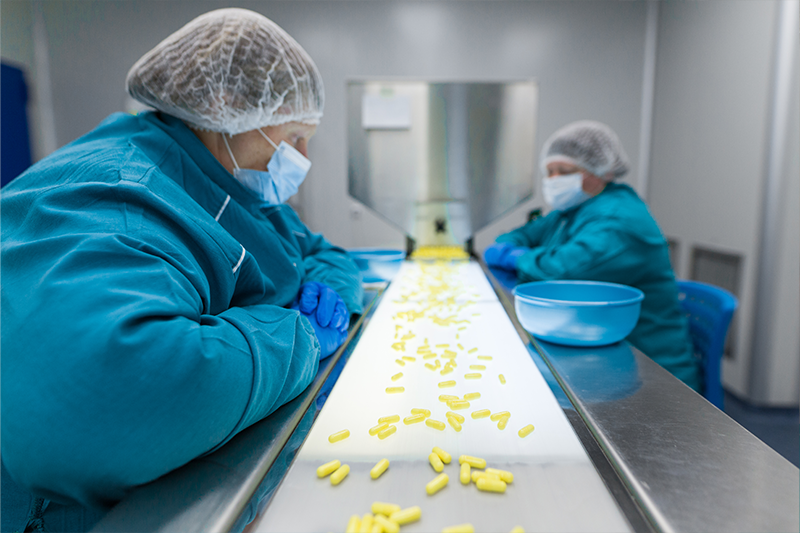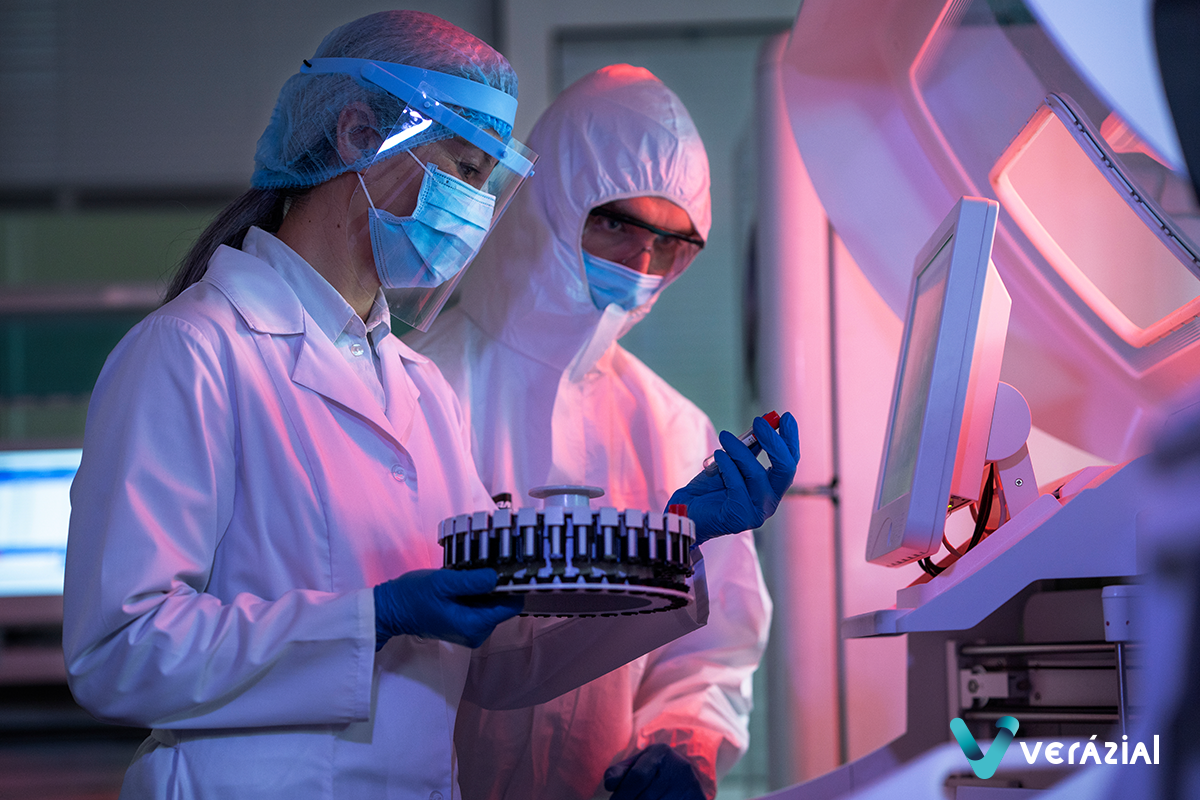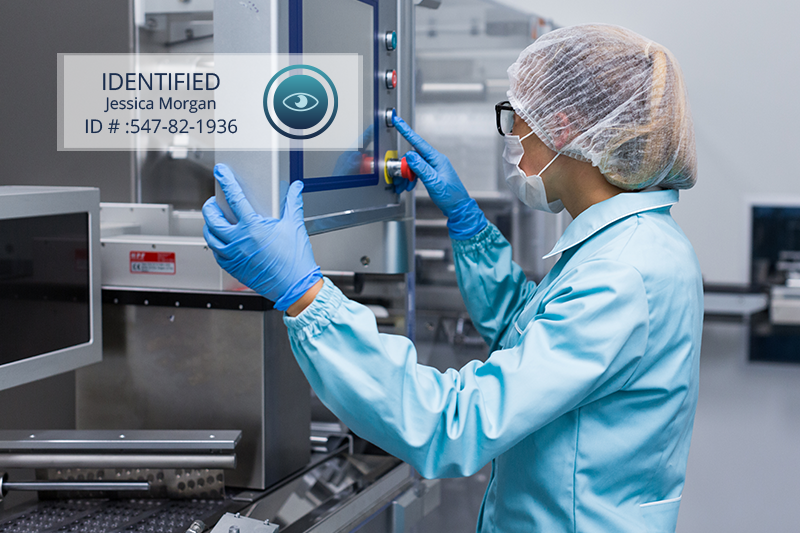GMP compliance in drug manufacturing
The pharmaceutical industry must ensure compliance with GMP regulations, which include a number of issues, including data integrity. The adoption of biometric technologies, such as iris or fingerprint recognition, emerges as the solution to ensure compliance.
In the pharmaceutical industry, Good Manufacturing Practices are placed as a fundamental and mandatory starting point. These regulations define the quality standards required for the manufacture and marketing of medicines for both human and veterinary use.
Within this industry, GMPs are part of a broader set known as Good Practices (GxP). This includes compliance with Good Laboratory Practices (GLP), Good Clinical Practices (GCP) and Good Distribution Practices (GDP). A more detailed description of these regulations is provided in our article GxP environments and their relevance to the pharmaceutical industry.
Good Manufacturing Practices (GMP) apply to a wide range of industries, including the manufacture of food, pharmaceuticals, cosmetics and medical products. These standards set out a series of guidelines that ensure that products are manufactured to an appropriate quality under specific conditions.
GMP are based on regulations issued by the European Medicines Agency (EMA), as well as on the guidelines established by the Food and Drug Administration (FDA) in the United States. In addition, the standards of the International Conference on Harmonization (ICH), in which both the EMA and the FDA actively participate, are considered.
In complying with these regulations, specific standards are established that address crucial aspects to ensure the quality and safety of manufactured drugs. The following is an analysis of the main regulations in each of these areas.
Main standards for GMP compliance
Personnel Performance
The success of GMP compliance is closely linked to personnel performance, which makes it a vitally important aspect when implemented in a company. Among the most significant personnel-related regulations are:
- It is essential that personnel are properly trained and possess the appropriate qualifications and experience for their roles. This ensures that they can carry out process controls effectively and accurately, thus contributing to the quality and safety of the products manufactured.
- Each task performed by personnel should be clearly defined and recorded in documented procedures. This avoids gaps in the application of manufacturing standards, ensuring data integrity and uniformity in the process.
- Companies should establish detailed hygiene programs tailored to their facilities and manufacturing processes. In addition, it is essential to keep personnel constantly trained through ongoing training programs. This ensures that they are aware of the latest practices and requirements in the manufacturing process.
- The people responsible for quality control must be dedicated exclusively to this function and be independent from other areas. This independence enables them to perform their duties impartially and effectively in assessing product quality.
Personnel must know and strictly comply with a series of safety and hygiene rules, such as the use of appropriate clothing according to the process, the prohibition of eating, drinking, smoking or chewing in manufacturing areas, and the correct use of hand washing and drying systems. These measures are essential to prevent contamination and guarantee product quality.
Facilities and equipment
Installations and equipment are critical elements in the manufacturing or product elaboration process. It is essential that they are properly qualified, calibrated and validated to ensure their proper functioning. In addition, all processes and procedures from receipt of raw materials to storage and distribution must be properly documented and validated.
Regarding the facilities and premises used for the production and storage of products, it is essential to follow a set of standards to ensure compliance with GMP:
- The facilities must be located in a suitable environment that minimizes contamination risks.
- Strict and regular cleaning and hygiene measures should be implemented to maintain the facilities in optimal conditions.
- Lighting, temperature and ventilation must be adequate for each process.
- Premises should be designed to prevent the entry of external agents such as animals, insects and dust.
- The work space should be used in such a way as to avoid risks such as cross-contamination and confusion between different processes.
- Restricted areas should be established for unauthorized personnel, ensuring that production, storage and quality control areas are not accessible to unauthorized people.
- The conservation of raw materials, the proper use of containers and packaging, and their storage should follow clear measures to guarantee their integrity and quality.
- The production area must take all necessary measures to ensure proper processing, following standards such as cleanliness, proper temperature, orderly storage and risk reduction.
Production, distribution and storage
The production, distribution and storage of products require following well-defined procedures that conform to established quality standards. Some general guidelines to be followed include:
- All processes related to the handling of products or raw materials should strictly follow documented protocols.
- Raw materials, products and packaging should be properly stored in conditions that promote their preservation.
- During all processes, it is essential that products, raw materials and packaging are clearly and permanently labeled to avoid any confusion.
- In production areas, only products that are properly documented can be produced.
- Measures should be taken to prevent cross-contamination, such as the use of appropriate extraction systems, closed production systems and the use of appropriate clothing for personnel.
- During receipt or delivery of materials or products, a detailed inspection of the condition of containers and packaging should be carried out to discard those that do not comply with the appropriate conditions, and these inspections should be properly recorded to ensure product traceability.
- Manufacturing, distribution and storage processes are subject to numerous regulations governing all aspects of the process to ensure exhaustive control of procedures.
Documentation
Adequate documentation is an essential component of the quality and safety assurance system, playing a fundamental role in compliance with GMP requirements. Among the requirements is the obligation to keep a record of all processes involved in the manufacture of medicines.
It is not enough to simply document the operations and sales planning processes; it is necessary to write them clearly and precisely, making sure that they are directly applicable to the resources and production capacities available in the company.
In the course of the manufacturing process, it is essential that procedures are recorded either manually or electronically. Keeping these records makes it possible to effectively and reliably demonstrate that all defined procedures and processes have been executed efficiently, guaranteeing the expected quality and quantity of the products obtained. Any significant deviation should be documented and lead to an investigation to identify its origin or cause.
Records associated with the manufacture and distribution of products, which enable the exhaustive traceability of a lot, should be kept in such a way that they are complete and readily available for consultation.

Main standards for GMP compliance
Data integrity and traceability of actions throughout the supply chain are essential aspects to comply with in GMP-regulated environments.
Ensuring data integrity implies that the data meet the ALCOA+ criteria, which means that the recorded data are attributable, legible, contemporaneous, original, accurate, complete, consistent, available and durable. This approach ensures the reliability and credibility of the information generated at each stage of the process. More information on this can be found in our article Employees´ identification in the pharmaceutical industry according ALCOA+.
To ensure data integrity within GMP environments, the implementation of biometric technologies has emerged as a valuable and effective solution. The implementation of biometrics allows identification through unique body characteristics, which eliminates any risk of error or impersonation.
This technology not only offers great convenience for users by avoiding the need for additional devices or the memorization of passwords, but also ensures traceability of actions and data integrity, fully complying with pharmaceutical industry regulations. We encourage you to read previous articles on our blog where we have addressed more on this topic.
References
- Image of two women working on assembly line with pills. [Freepik]
GMP compliance in drug manufacturing
The pharmaceutical industry must ensure compliance with GMP regulations, which include a number of issues, including data integrity. The adoption of biometric technologies, such as iris or fingerprint recognition, emerges as the solution to ensure compliance.
In the pharmaceutical industry, Good Manufacturing Practices are placed as a fundamental and mandatory starting point. These regulations define the quality standards required for the manufacture and marketing of medicines for both human and veterinary use.
Within this industry, GMPs are part of a broader set known as Good Practices (GxP). This includes compliance with Good Laboratory Practices (GLP), Good Clinical Practices (GCP) and Good Distribution Practices (GDP). A more detailed description of these regulations is provided in our article GxP environments and their relevance to the pharmaceutical industry.
Good Manufacturing Practices (GMP) apply to a wide range of industries, including the manufacture of food, pharmaceuticals, cosmetics and medical products. These standards set out a series of guidelines that ensure that products are manufactured to an appropriate quality under specific conditions.
GMP are based on regulations issued by the European Medicines Agency (EMA), as well as on the guidelines established by the Food and Drug Administration (FDA) in the United States. In addition, the standards of the International Conference on Harmonization (ICH), in which both the EMA and the FDA actively participate, are considered.
In complying with these regulations, specific standards are established that address crucial aspects to ensure the quality and safety of manufactured drugs. The following is an analysis of the main regulations in each of these areas.
Main standards for GMP compliance
Personnel Performance
The success of GMP compliance is closely linked to personnel performance, which makes it a vitally important aspect when implemented in a company. Among the most significant personnel-related regulations are:
- It is essential that personnel are properly trained and possess the appropriate qualifications and experience for their roles. This ensures that they can carry out process controls effectively and accurately, thus contributing to the quality and safety of the products manufactured.
- Each task performed by personnel should be clearly defined and recorded in documented procedures. This avoids gaps in the application of manufacturing standards, ensuring data integrity and uniformity in the process.
- Companies should establish detailed hygiene programs tailored to their facilities and manufacturing processes. In addition, it is essential to keep personnel constantly trained through ongoing training programs. This ensures that they are aware of the latest practices and requirements in the manufacturing process.
- The people responsible for quality control must be dedicated exclusively to this function and be independent from other areas. This independence enables them to perform their duties impartially and effectively in assessing product quality.
Personnel must know and strictly comply with a series of safety and hygiene rules, such as the use of appropriate clothing according to the process, the prohibition of eating, drinking, smoking or chewing in manufacturing areas, and the correct use of hand washing and drying systems. These measures are essential to prevent contamination and guarantee product quality.
Facilities and equipment
Installations and equipment are critical elements in the manufacturing or product elaboration process. It is essential that they are properly qualified, calibrated and validated to ensure their proper functioning. In addition, all processes and procedures from receipt of raw materials to storage and distribution must be properly documented and validated.
Regarding the facilities and premises used for the production and storage of products, it is essential to follow a set of standards to ensure compliance with GMP:
- The facilities must be located in a suitable environment that minimizes contamination risks.
- Strict and regular cleaning and hygiene measures should be implemented to maintain the facilities in optimal conditions.
- Lighting, temperature and ventilation must be adequate for each process.
- Premises should be designed to prevent the entry of external agents such as animals, insects and dust.
- The work space should be used in such a way as to avoid risks such as cross-contamination and confusion between different processes.
- Restricted areas should be established for unauthorized personnel, ensuring that production, storage and quality control areas are not accessible to unauthorized people.
- The conservation of raw materials, the proper use of containers and packaging, and their storage should follow clear measures to guarantee their integrity and quality.
- The production area must take all necessary measures to ensure proper processing, following standards such as cleanliness, proper temperature, orderly storage and risk reduction.
Production, distribution and storage
The production, distribution and storage of products require following well-defined procedures that conform to established quality standards. Some general guidelines to be followed include:
- All processes related to the handling of products or raw materials should strictly follow documented protocols.
- Raw materials, products and packaging should be properly stored in conditions that promote their preservation.
- During all processes, it is essential that products, raw materials and packaging are clearly and permanently labeled to avoid any confusion.
- In production areas, only products that are properly documented can be produced.
- Measures should be taken to prevent cross-contamination, such as the use of appropriate extraction systems, closed production systems and the use of appropriate clothing for personnel.
- During receipt or delivery of materials or products, a detailed inspection of the condition of containers and packaging should be carried out to discard those that do not comply with the appropriate conditions, and these inspections should be properly recorded to ensure product traceability.
- Manufacturing, distribution and storage processes are subject to numerous regulations governing all aspects of the process to ensure exhaustive control of procedures.
Documentation
Adequate documentation is an essential component of the quality and safety assurance system, playing a fundamental role in compliance with GMP requirements. Among the requirements is the obligation to keep a record of all processes involved in the manufacture of medicines.
It is not enough to simply document the operations and sales planning processes; it is necessary to write them clearly and precisely, making sure that they are directly applicable to the resources and production capacities available in the company.
In the course of the manufacturing process, it is essential that procedures are recorded either manually or electronically. Keeping these records makes it possible to effectively and reliably demonstrate that all defined procedures and processes have been executed efficiently, guaranteeing the expected quality and quantity of the products obtained. Any significant deviation should be documented and lead to an investigation to identify its origin or cause.
Records associated with the manufacture and distribution of products, which enable the exhaustive traceability of a lot, should be kept in such a way that they are complete and readily available for consultation.

Main standards for GMP compliance
Data integrity and traceability of actions throughout the supply chain are essential aspects to comply with in GMP-regulated environments.
Ensuring data integrity implies that the data meet the ALCOA+ criteria, which means that the recorded data are attributable, legible, contemporaneous, original, accurate, complete, consistent, available and durable. This approach ensures the reliability and credibility of the information generated at each stage of the process. More information on this can be found in our article Employees´ identification in the pharmaceutical industry according ALCOA+.
To ensure data integrity within GMP environments, the implementation of biometric technologies has emerged as a valuable and effective solution. The implementation of biometrics allows identification through unique body characteristics, which eliminates any risk of error or impersonation.
This technology not only offers great convenience for users by avoiding the need for additional devices or the memorization of passwords, but also ensures traceability of actions and data integrity, fully complying with pharmaceutical industry regulations. We encourage you to read previous articles on our blog where we have addressed more on this topic.
References
- Image of two women working on assembly line with pills. [Freepik]
GMP compliance in drug manufacturing
The pharmaceutical industry must ensure compliance with GMP regulations, which include a number of issues, including data integrity. The adoption of biometric technologies, such as iris or fingerprint recognition, emerges as the solution to ensure compliance.
In the pharmaceutical industry, Good Manufacturing Practices are placed as a fundamental and mandatory starting point. These regulations define the quality standards required for the manufacture and marketing of medicines for both human and veterinary use.
Within this industry, GMPs are part of a broader set known as Good Practices (GxP). This includes compliance with Good Laboratory Practices (GLP), Good Clinical Practices (GCP) and Good Distribution Practices (GDP). A more detailed description of these regulations is provided in our article GxP environments and their relevance to the pharmaceutical industry.
Good Manufacturing Practices (GMP) apply to a wide range of industries, including the manufacture of food, pharmaceuticals, cosmetics and medical products. These standards set out a series of guidelines that ensure that products are manufactured to an appropriate quality under specific conditions.
GMP are based on regulations issued by the European Medicines Agency (EMA), as well as on the guidelines established by the Food and Drug Administration (FDA) in the United States. In addition, the standards of the International Conference on Harmonization (ICH), in which both the EMA and the FDA actively participate, are considered.
In complying with these regulations, specific standards are established that address crucial aspects to ensure the quality and safety of manufactured drugs. The following is an analysis of the main regulations in each of these areas.
Main standards for GMP compliance
Personnel Performance
The success of GMP compliance is closely linked to personnel performance, which makes it a vitally important aspect when implemented in a company. Among the most significant personnel-related regulations are:
- It is essential that personnel are properly trained and possess the appropriate qualifications and experience for their roles. This ensures that they can carry out process controls effectively and accurately, thus contributing to the quality and safety of the products manufactured.
- Each task performed by personnel should be clearly defined and recorded in documented procedures. This avoids gaps in the application of manufacturing standards, ensuring data integrity and uniformity in the process.
- Companies should establish detailed hygiene programs tailored to their facilities and manufacturing processes. In addition, it is essential to keep personnel constantly trained through ongoing training programs. This ensures that they are aware of the latest practices and requirements in the manufacturing process.
- The people responsible for quality control must be dedicated exclusively to this function and be independent from other areas. This independence enables them to perform their duties impartially and effectively in assessing product quality.
Personnel must know and strictly comply with a series of safety and hygiene rules, such as the use of appropriate clothing according to the process, the prohibition of eating, drinking, smoking or chewing in manufacturing areas, and the correct use of hand washing and drying systems. These measures are essential to prevent contamination and guarantee product quality.
Facilities and equipment
Installations and equipment are critical elements in the manufacturing or product elaboration process. It is essential that they are properly qualified, calibrated and validated to ensure their proper functioning. In addition, all processes and procedures from receipt of raw materials to storage and distribution must be properly documented and validated.
Regarding the facilities and premises used for the production and storage of products, it is essential to follow a set of standards to ensure compliance with GMP:
- The facilities must be located in a suitable environment that minimizes contamination risks.
- Strict and regular cleaning and hygiene measures should be implemented to maintain the facilities in optimal conditions.
- Lighting, temperature and ventilation must be adequate for each process.
- Premises should be designed to prevent the entry of external agents such as animals, insects and dust.
- The work space should be used in such a way as to avoid risks such as cross-contamination and confusion between different processes.
- Restricted areas should be established for unauthorized personnel, ensuring that production, storage and quality control areas are not accessible to unauthorized people.
- The conservation of raw materials, the proper use of containers and packaging, and their storage should follow clear measures to guarantee their integrity and quality.
- The production area must take all necessary measures to ensure proper processing, following standards such as cleanliness, proper temperature, orderly storage and risk reduction.
Production, distribution and storage
The production, distribution and storage of products require following well-defined procedures that conform to established quality standards. Some general guidelines to be followed include:
- All processes related to the handling of products or raw materials should strictly follow documented protocols.
- Raw materials, products and packaging should be properly stored in conditions that promote their preservation.
- During all processes, it is essential that products, raw materials and packaging are clearly and permanently labeled to avoid any confusion.
- In production areas, only products that are properly documented can be produced.
- Measures should be taken to prevent cross-contamination, such as the use of appropriate extraction systems, closed production systems and the use of appropriate clothing for personnel.
- During receipt or delivery of materials or products, a detailed inspection of the condition of containers and packaging should be carried out to discard those that do not comply with the appropriate conditions, and these inspections should be properly recorded to ensure product traceability.
- Manufacturing, distribution and storage processes are subject to numerous regulations governing all aspects of the process to ensure exhaustive control of procedures.
Documentation
Adequate documentation is an essential component of the quality and safety assurance system, playing a fundamental role in compliance with GMP requirements. Among the requirements is the obligation to keep a record of all processes involved in the manufacture of medicines.
It is not enough to simply document the operations and sales planning processes; it is necessary to write them clearly and precisely, making sure that they are directly applicable to the resources and production capacities available in the company.
In the course of the manufacturing process, it is essential that procedures are recorded either manually or electronically. Keeping these records makes it possible to effectively and reliably demonstrate that all defined procedures and processes have been executed efficiently, guaranteeing the expected quality and quantity of the products obtained. Any significant deviation should be documented and lead to an investigation to identify its origin or cause.
Records associated with the manufacture and distribution of products, which enable the exhaustive traceability of a lot, should be kept in such a way that they are complete and readily available for consultation.

Main standards for GMP compliance
Data integrity and traceability of actions throughout the supply chain are essential aspects to comply with in GMP-regulated environments.
Ensuring data integrity implies that the data meet the ALCOA+ criteria, which means that the recorded data are attributable, legible, contemporaneous, original, accurate, complete, consistent, available and durable. This approach ensures the reliability and credibility of the information generated at each stage of the process. More information on this can be found in our article Employees´ identification in the pharmaceutical industry according ALCOA+.
To ensure data integrity within GMP environments, the implementation of biometric technologies has emerged as a valuable and effective solution. The implementation of biometrics allows identification through unique body characteristics, which eliminates any risk of error or impersonation.
This technology not only offers great convenience for users by avoiding the need for additional devices or the memorization of passwords, but also ensures traceability of actions and data integrity, fully complying with pharmaceutical industry regulations. We encourage you to read previous articles on our blog where we have addressed more on this topic.
References
- Image of two women working on assembly line with pills. [Freepik]
You May Also Like
You May Also Like





